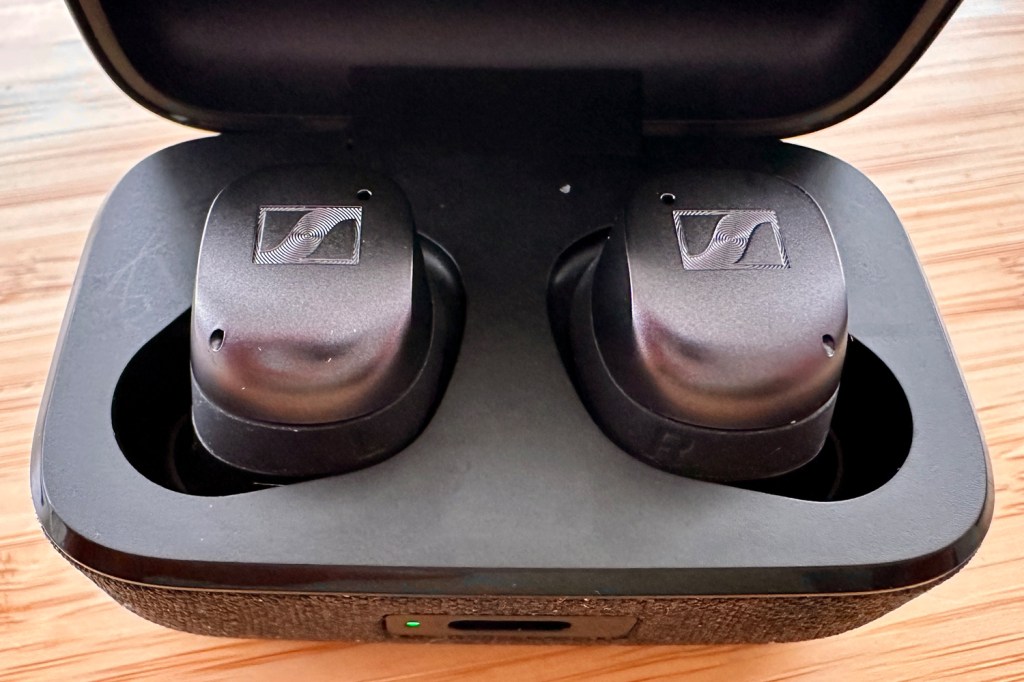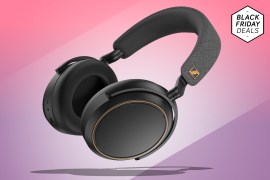Sennheiser Momentum True Wireless 4 review: the same, but more
Looks familiar, sounds even better

Stuff Verdict
They may not look like it, but the Sennheiser Momentum True Wireless 4 are a definite upgrade on the model they replace
Pros
- Positive, detailed and spacious sound
- Impressive specification
- Properly built and finished
Cons
- No spatial audio capability
- Not the most dynamic sound
- Plenty of decent rivals
Introduction
Sennheiser launched its first Momentum True Wireless in-ear headphones almost exactly five years ago. But while it doesn’t seem to have taken all that long to get to the product’s fourth generation, the differences between the original Momentum and this latest version go a long way to explaining how wireless audio technology has advanced in all directions.
And nothing happens in isolation, of course – Sennheiser’s hardly the only brand trying to advance the art of the wireless earbud. The original Momentum were competitive in 2019, sure – do the fourth generation have what it takes in 2024?
How we test headphones
Every pair of earphones and headphones reviewed on Stuff is used for a minimum of a week’s worth of daily listening. We use a playlist of test tracks made up of multiple genres to assess sound, and use our years of experience to compare to other models. Manufacturers have no visibility on reviews before they appear online, and we never accept payment to feature products.
Find out more about how we test and rate products.
Design & build: plus ca change


At first look, there’s virtually nothing to differentiate the Momentum True Wireless 4 from the Momentum True Wireless 3 that launched in 2022 (and that will no doubt be available with a chunky discount soon enough). The shape of the earbuds and their changing case, their dimensions and weight, are to all intents and purposes identical.
Only an understated metallic treatment to the top of the earbuds, and the inclusion of a new ‘black copper’ finish as an alternative to ‘metallic silver’ or the ‘graphite’ of my review sample, lets you tell them apart.
Sennheiser provides a choice of silicone eartips and silicone stability fins in the packaging. Combine these with a light, ergonomic and comfortable design, and a fit test embedded in the control app, and there seems no chance you won’t be able to achieve an enduringly comfortable fit from this design.
Something else that hasn’t really changed: the quality of build and finish. As everyone routinely expects from Sennheiser, the Momentum True Wireless 4 are expertly assembled using high-quality materials, and are built to last. I’m sure people are still using their original Momentum True Wireless after five years, and it wouldn’t surprise me if people are still using their Momentum True Wireless 4 in 2029.
Features & battery: letters and numbers


Given the number of earbuds that have launched lately with some kind of spatial audio functionality or other, it’s mildly surprising to find Sennheiser hasn’t included something similar here. Perhaps it’s just as well – these earbuds have such a complete feature-set in every other way that I have plenty to write about anyway.
The headline specifications are all about wireless connectivity. The Momentum True Wireless 4 use Bluetooth 5.4 – which is about as good (meaning efficient, stable, and adaptable) as it currently gets. Codec compatibility runs not only to SBC, AAC and aptX Adaptive but, thanks to Qualcomm’s Snapdragon Sound platform, aptX Lossless too. Anyone with an appropriate source player should be able to enjoy full-on lossless 16bit/44.1kHz CD standard streams, wirelessly. Bluetooth LE Audio with LC3 and Auracast will be arriving via over-the-air firmware update at any moment, too. Multipoint connectivity is available, and there’s a gaming-friendly low latency mode too.
A reimagined antenna design means improved wireless range and increased rejection of transmission interference. And once the digital audio information is on board, it’s handed over to your ears by a couple of 7mm full-range dynamic drivers that are carried over pretty much unchanged from the MTW3.
Bluetooth 5.4 contributes a little to the very competitive battery life available here, too. The earbuds can run for over seven hours between charges (as long as you haven’t gone all-in on the volume, of course), and with the charging case you can expect around 30 hours of action before you need to visit mains power.
The charging case has a USB-C socket, and is also compatible with Qi-certified charging pads – from flat to full takes a couple of hours, but eight minutes or so is good for an hour’s playback. And as well as good between-charges figures, Sennheiser hopes its new optimised charging system will monitor charging cycles in order to extend the battery’s lifespan.
Active noise cancellation is included too, naturally enough, and it’s an adaptive system that monitors and responds to your environment. There’s an anti wind-noise feature that can be selected, as well as a transparency setting that allows a user-specified amount of external sound in.
Interface: the art of the app



If you’re familiar with Sennheiser’s Smart Control phone app, you’ll know it’s one of the best around. If you’re not, well, take my word for it. It’s stable, easy to navigate, logical in its layout and offers a stack of end-user adjustment that’s not necessarily offered by nominal rivals.
For example, the app allows you to rearrange the response of the capacitive touch-control on each earbud. It lets you adjust the amount of external sound admitted when you’re in transparency mode. It has a five-band EQ with quite a number of presets, and the option to save some custom settings of your own. It lets you specify the maximum audio resolution, and customise the overall appearance of the app to best suit your requirements. In short, if this app doesn’t let you do it, it’s because it’s not worth doing.
Once you’ve used the app to arrange the touch-controls to your liking, they’re prompt and responsive in use. The six-mic array that takes care of the adaptive noise cancellation and telephony also prove more than up to the task of allowing you to interact, reliably, with your source player’s native voice assistant.
Sound quality and noise cancelling: the more the merrier



In almost every respect, the Sennheiser Momentum True Wireless 4 are an uncomplicatedly enjoyable listen. They do their best work when given the best tools to work with, of course – who doesn’t? – but they’re admiravly unfussy about the quality or type of digital audio file you stream in.
A 320kbps Spotify stream of Cypress Hill’s The Phunky Feel One makes the point. Detail levels are pretty high considering the amount of compression the file has undergone, and there’s straight-edge punch and control at the bottom of the frequency range. The hectoring voice in the midrange is given plenty of space and expression, and there’s a reasonable amount of drive and attack to the top end. Tonality is neutral enough, and the recording lopes forward in a completely believable manner.
The Sennheiser are capable of a fair bit more, though – and when the switch to a 24bit/96kHz file of The Smoke by The Smile is made, ‘a fair bit more’ is what you get as a listener. The sound is fuller and more spacious, with greater impetus and momentum, more positivity where rhythmic expression is concerned, and a whole lot more fine detail revealed at every point. The soundstage is clearer and better organised, and there’s a more greater sense of unity and singularity to the presentation – it sounds like an authentic performance.
What there isn’t quite enough of, though, is dynamic headroom. Changes in intensity are identified and reported on, sure – but the Sennhesier seem unwilling or unable to express thise changes, or big shifts in volume and attack, with quite as much certainty as some other, similarly priced designs. To say they sound ‘matter of fact’ is overstating it, but they’re definitely not as energetic in this respect as they might be.
Noise cancellation is pretty much the same. There’s not much point in complaining that the ANC here isn’t as good as you’ll find on a pair of Bose true wireless, because nobody’s is. But while the Momentum True Wireless 4 definitely do a job on external sounds, it’s not as complete as it might be – which is to say, it’s not as complete as all those alternatives that are pretty good at the ANC thing without being as good as Bose.
Sennheiser Momentum True Wireless 4 verdict

To absolutely no one’s surprise, the Sennheiser Momentum True Wireless 4 turn out to be a killer combination of specification, form and function.
They’re keenly priced, too, undercutting Bose and matching Apple, Sony and the rest. If you value sound and build quality, they’re a great pick.
Stuff Says…
They may not look like it, but the Momentum True Wireless 4 are a definite upgrade on the model they replace
Pros
Positive, detailed and spacious sound
Impressive specification
Properly built and finished
Cons
No spatial audio capability
Not the most dynamic sound
Plenty of decent rivals
Sennheiser Momentum True Wireless 4 technical specifications
| Drivers | 7mm dynamic |
| ANC | Yes |
| Bluetooth version | Bluetooth 5.4 |
| Codecs supported | SBC, AAC, aptX Adaptive/Lossless, LC3 |
| Durability | IP54 |
| Battery life | 7hrs/7.5hrs (ANC on/off, buds) Up to 30 hours (case and buds) |
| Dimensions | 70.1×44.6×34.8mm (case) 6.2g (buds), 66.4g (case) |



